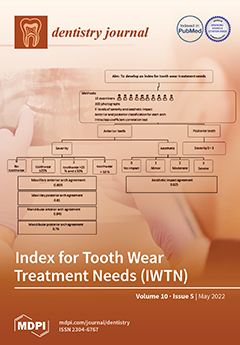- Autor:
- Eduardo Anitua
- Mohammad H. Alkhraisat
- Carlos Flores
- Sofía Fernández de Retana
- Beatriz Anitua
Performance of Immediately Loaded Short Dental Implants Using Low-Speed Drilling Protocol and Plasma Rich in Growth Factors: A Controlled Retrospective Observational Study
Narrow dental implants are commonly used to restore narrow alveolar ridges. Although the good performance of narrow dental implants supporting multiple prostheses has been repeatedly demonstrated, there are few studies analyzing their performance in a long-term follow-up together with the influence of the loading protocol. Thus, the objective was to assess the influence of implant loading protocol (immediate vs delayed) on the long-term outcomes of 3.0-mm-diameter dental implants supporting fixed multiple prostheses.
- Autor:
- Eduardo Anitua
- Mohammad H. Alkhraisat
- Diez GG
- Castellanos N
- Vázquez C
- Galindo-Villardón P
The effect of mindfulness on the inflammatory, psychological and biomechanical domains of adult patients with low back pain: A randomized controlled clinical trial
This study aims to study the effect of mindfulness-based program on the psychological, biomechanical and inflammatory domains of patients with chronic low back pain
- Autor:
- Eduardo Anitua
- Mohammad H. Alkhraisat
- Asier Eguia
- Allende M
Bone-Regenerative Ability of Platelet-Rich Plasma Following Sinus Augmentation with Anorganic Bovine Bone: A Systematic Review with Meta-Analysis
The objective of this systematic review is to assess the effect of the adjuvant use of platelet-rich plasma (PRP) and its type on new bone formation by anorganic bovine bone during maxillary sinus floor augmentation procedure
- Autor:
- Eduardo Anitua
- Mohammad H. Alkhraisat
- Allende M
Unravelling Alveolar Bone Regeneration Ability of Platelet-Rich Plasma: A Systematic Review with Meta-Analysis
This systematic review aims to evaluate the efficacy of the available platelet-rich plasma (PRP) products and composition to regenerate alveolar bone after tooth extraction.
- Autor:
- Eduardo Anitua
- Mohammad H. Alkhraisat
- Javier Flores
- Sofia Fernandez de Retana
Single-Unit Short Implants in the Molar Region: A Retrospective Study with a Minimum 3-Year Follow-up
The high biomechanical loads in molar region wounds challenge the indication for short implants to be used as a single-unit implant. This study reports on the outcomes of single-unit short implants (≤ 8.0 mm) in the maxillary and mandibular molar regions. Forty-nine short implants were placed in 48 patients to replace a missing molar tooth.
- Autor:
- Eduardo Anitua
- Naiara Larrazabal Saez de Ibarra
- Iñigo Morales Martín
- Luis Saracho Rotaeche
Influence of Implant Tilting and Length on the Biomechanics of Single-Tooth Restoration: A Finite Element Analysis in Atrophic Mandible
The application of the counter-torque technique has been proposed as a conservative and atraumatic alternative for the explantation of nonmobile dental implants. The objective of this report is to assess the performance of this technique in a large number of patients.
- Autor:
- Eduardo Anitua
- Sabino Padilla
- Antonio Rios
- Homid Fahandezh-Saddi Díaz
- Manuel Villanueva Martinez
- Roberto Prado
Office-Based Intraosseous Infiltrations of PRGF in Knee Osteoarthritis: Description of Technique
The application of the counter-torque technique has been proposed as a conservative and atraumatic alternative for the explantation of nonmobile dental implants. The objective of this report is to assess the performance of this technique in a large number of patients.
- Autor:
- Eduardo Anitua
- Ricardo Tejero
Coarse Surface Microcavities Permit Bone Ingrowth and Improve Implant Osseointegration
Narrow dental implants are commonly used to restore narrow alveolar ridges. Although the good performance of narrow dental implants supporting multiple prostheses has been repeatedly demonstrated, there are few studies analyzing their performance in a long-term follow-up together with the influence of the loading protocol. Thus, the objective was to assess the influence of implant loading protocol (immediate vs delayed) on the long-term outcomes of 3.0-mm-diameter dental implants supporting fixed multiple prostheses.
- Autor:
- Eduardo Anitua
- Gorka Orive
- Mar Zalduendo
- María Troya
- Itsasne Erezuma
- Izeia Lukin
- Raquel Hernáez-Moya
Composite alginate-gelatin hydrogels incorporating PRGF enhance human dental pulp cell adhesion, chemotaxis and proliferation
The increasing prevalence of tissue injuries is fueling the development of autologous biological treatments for regenerative medicine. Here, we investigated the potential of three different bioinks based on the combination of gelatin and alginate (GA), enriched in either hydroxyapatite (GAHA) or hydroxyapatite and PRGF (GAHAP), as a favorable microenvironment for human dental pulp stem cells (DPSCs)
Oral Lichen Planus Treated With Plasma Rich in Growth Factors
Narrow dental implants are commonly used to restore narrow alveolar ridges. Although the good performance of narrow dental implants supporting multiple prostheses has been repeatedly demonstrated, there are few studies analyzing their performance in a long-term follow-up together with the influence of the loading protocol. Thus, the objective was to assess the influence of implant loading protocol (immediate vs delayed) on the long-term outcomes of 3.0-mm-diameter dental implants supporting fixed multiple prostheses.

 English
English
 Français
Français
 Italiano
Italiano
 Português
Português










